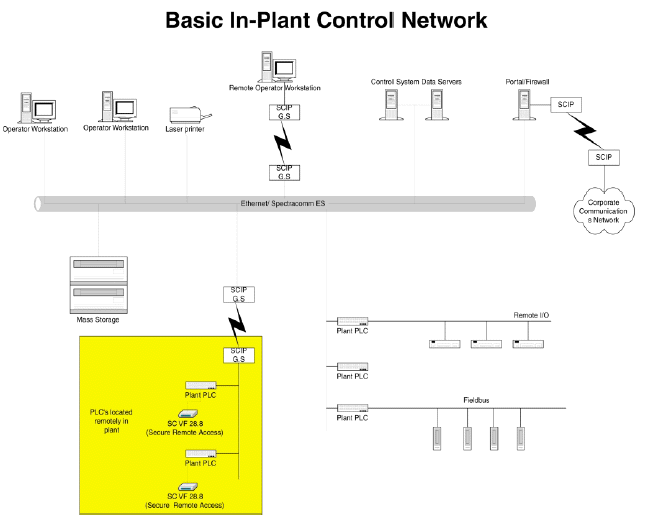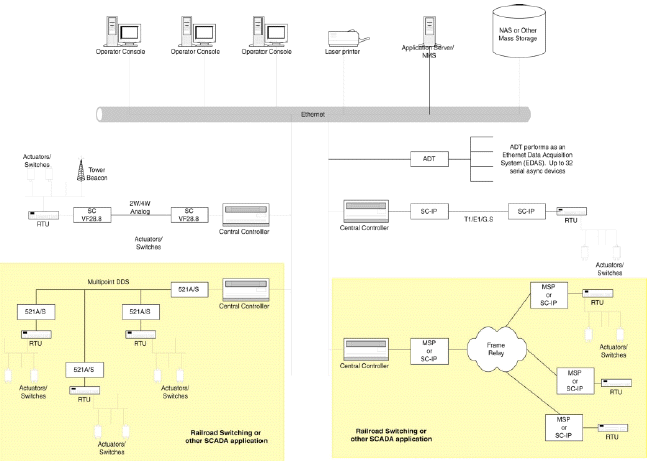
| GDC General DataComm |
GDC General DataComm Implementations for Securing Distributed Control System DCS and Supervisory Control and Data Acquisition SCADA Networks
General DataComm SCADA Modbus/TCP (Modbus protocol over TCP/IP, EtherNet/IP (ControlNet/DeviceNet over TCP/IP), Fieldbus High-Speed Ethernet and ProfiNet (Profibus over Ethenet).
GDC Implementations for Securing Distributed Control System
(DCS) and Supervisory Control and Data Acquisition (SCADA) Networks
Introduction
Since September 11, 2001 United States agencies involved with national security
have become
increasingly concerned about the vulnerability of the North American power grid,
water supply,
refining, nuclear facilities and railroads to electronic intrusions or “cyber
attacks”. Several
studies have been conducted and have identified changing socio-economic
conditions that
increase the probability of such computer-based attacks. Increased domestic and
international
terrorism, industry related issues affecting the utilities job market, the shift
to more open
standards for interconnection of DCS and SCADA networks and a growing population
of
computer-literate people with widely available hacker tools are factors that
contribute greatly to
the likelihood of such threats.
In this paper, we will identify and discuss threat origins and how technologies
available today
from GDC can mitigate these threats and be part of a comprehensive network
design and security
policy to ensure safe and secure communications between components of DCS and
SCADA
networks.
What is a DCS or SCADA network?
DCS are used to control large, complex processes such as power plants,
refineries, and chemical
plants typically, but not always, at a single site. A DCS is comprised of a
supervisory layer of
control and one or more distributed controllers contained within the same
processing plant. The
supervisory controller runs on a central server and communicates with
subordinate controllers
via some form of peer-to-peer network. The supervisor sends set points to and
requests data
from the distributed controllers. The distributed controllers control their
process actuators
(switches, valves, flow controllers, etc) based on requests from the supervisor.
These controllers
typically use a local field bus to communicate with the actuators and sensors
eliminating the need
for point-to-point wiring to each device. Many times, the distributed
controllers in a DCS have
the capability to be accessed via a modem allowing remote diagnostics and
servicing by vendors
and plant engineers.
A SCADA network typically consists for a Central Monitoring System (CMS),
contained at a
central plant for example and one or more Remote Stations. The CMS houses the
Control Server
and the communications access via a peer-to-peer network. The CMS collects and
logs
information gathered at the Remote Stations and generates necessary actions
based on the
gathered data. A Remote Station consists of either a Remote Terminal Unit (RTU)
or a
Programmable Logic Controller (PLC) which controls actuators and monitors
sensors. Remote
Stations typically have the capability to be interfaced by field operators via
laptops or other
handheld devices to perform diagnostics and repair operations. The
communications network is
the medium for transmitting information between Remote Stations and the CMS.
These facilities
can be telco lines, cable, or RF.
Fieldbus - Ethernet
It is important to understand that DCS and SCADA based industries are undergoing
a change in
how these networks are implemented. Controller networks typically were based on
proprietary
serial cabling and/or fieldbus architectures (Fieldbus, Modbus, Profibus) which
have upper data
limits of about 2Mbps, node limitations, and distance limitations which all
varied from
technology to technology. This would all need to pass through a gateway to get
to the internal IT
network a very cumbersome approach. The development of Ethernet-capable
controllers and
PLCs and the need for integration of other requirements (security devices, bar
code scanners,
smart cards, etc) are helping to drive the industry towards more open and
ubiquitous
architectures. This shift is also made apparent by the fact that many vendors
are encapsulating
the bus protocols into TCP/IP: Modbus/TCP (Modbus protocol over TCP/IP, EtherNet/IP
(ControlNet/DeviceNet over TCP/IP), Fieldbus High-Speed Ethernet and ProfiNet (Profibus
over Ethenet). Ethernet is quickly becoming a larger part of DCS and SCADA
network
implementations, in some cases replacing or augmenting the older bus-type
architectures.
Threats
As demonstrated daily, any TCP/IP based network is subject to intrusion. These
intrusions come
from numerous sources including:
Threats from within:
-- Company staff, technician, operators.
-- Security breaches may not be intentional, BUT….
-- Emailed viruses
Threats from the outside:
-- 3rd party support services
-- Communications lines
-- Vandalism/terrorism
Security measures should not be taken lightly. Remember, if your network is easy
for your
IT Department to manage, it is most likely easy for an outside party to
infiltrate.
How can GDC address security issues with DCS and
SCADA networks?
GDC products should be part of a comprehensive secure network implementation.
Other
elements that should be addressed are policies and enforcement, virus detection
and prevention,
firewalls, and Intrusion Detection Systems (IDS). GDC’s line of secure modems
and IP access
products can be the first line of defense at the most basic levels of your
network – OSI Layers 1
and 2.
As stated earlier, most legacy DCS/SCADA networks have modem access to some
controllers
(and potentially elsewhere) for remote maintenance and troubleshooting. GDC’s
family of V.34
modems with Steadfast Security and additionally RADIUS authentication can make
these
connections “hack-proof”. GDC’s Steadfast Security, which is a proprietary,
handshake-based
exchange requires a GDC modem at both ends. If the handshake password exchange
is not
completed properly, the call is dropped before ever being connected to the
network. With a
common length password of 6-8 alphanumeric, it would be statistically impossible
for any hacker
to gain access, assuming they have a GDC modem Additionally, adding RADIUS
authentication
security where applicable would further enhance the security.
With the migration/augmentation of the DCS and SCADA peer-to-peer networks to
10/100
Ethernet, GDC’s line of IP access products, SpectraComm IP (SCIP) and
SpectraComm
Ethernet switch (SCES) can provide first-line intrusion prevention. All of the
SpectraComm IP
and Ethernet switch units implement GDC IronGate Security features. These
features, including
port-based shutdown and MAC address filtering, can limit access only to
authorized devices and
personnel as designated by the MAC Address tables configured in the unit by the
network
administrator. It should be noted that a SCIP unit in LAN Extension (LAN-X) mode
can not only
filter MAC addresses on the LAN, but can also filter on the WAN port as well to
ensure that
unauthorized access does not occur from the circuit (Telco facilities).
Additionally, the SCIP and
SCES implement industry-standard TACACS+ compatible clients for centralized
authentication.

In large-scale processing facilities, the SCIP T1 (1.544
Mbps up to 5000 feet without repeaters) or
SCIP G.S (4 Mbps up to 7000 feet on 1 pair or up to 12,000 feet on 2 pair) in
LAN Extension (LANX)
mode, can extend the reach between the Central and Distributed Controller well
beyond the
100 meter reach of Ethernet alone. Implementing the MAC-based filtering and/or
TACACS+ in
these situations allows maintenance personnel to attach to the network at the
SCIP as determined
by the network administrator.
In SCADA RTU applications, the SCIP T1 in LAN-X mode and SCES offer a compelling
and
secure solution where one might typically install a router with its associated
costs. Implementing
the MAC-based filtering and/or TACACS+ allows only authorized maintenance
personnel to
access the network via the SCIP/SCES as determined by the network administrator.
Additionally, the Contact Sense feature on the SCIP could be implemented to
alert network
monitoring personnel of such things as door opening, high water, high heat, etc.
at the Remote
Station if so desired.
SCIP and SCES have been independently tested and certified
to stringent NEBS Level 3+
requirements for Telcos and additional testing have proven them to be consistent
with the
classification as temperature “hardened” (-40 o C to +70 o C) for deployment in
extreme
environments.
Typical SCADA Application

Conclusion
As has been shown, GDC offers a compelling and competitive solution for
first-line defense and
intrusion prevention. The combination of Steadfast Security for dial connections
and GDC
IronGate Security for Ethernet connectivity, address the most basic levels of
secure networking
for DCS and SCADA applications as part of a comprehensive security policy.
-
Purchase orders accepted on General
DataComm equipment
- Contract Buying and Volume Discounts available !!
- Please contact us @ 301-924-7400 EXT 25 for Sales
ARC ELECTRONICS
301-924-7400 EXT 25
jump to ...
Home
Page
arc@arcelect.com